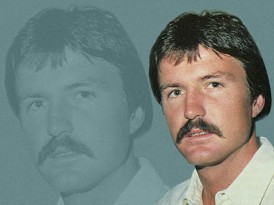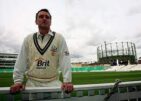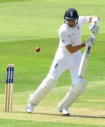Martin Kent
Gareth Bland |
Richie Benaud once said that there are many good batsmen, a few that are very good and a very select number that, it can be said, may rightly have the epithet “great” bestowed upon them. It is not known what the sage of Penrith, New South Wales says about the grading of batsmen whose impact could have been much, much greater had the cricketing Gods decreed otherwise. One such batsman was Martin Francis Kent, the silky Queensland right-hander who toured England in 1981 with Kim Hughes’s team. After just three Tests and much promise Kent’s career was cut short due to a debilitating spinal injury. Overshadowed, as were all others by a certain Cheshire born all-rounder during that summer’s Test series, Kent’s demonstrable promise and poise in the middle-order was enough to point to a rosy future in the Australian side. That promise never reached fruition, however, and Kent’s international career came to a close with that summer’s series at the Oval in early September.
Kent had made his limited overs international debut the previous winter during the Benson Hedges World Series Cup as Australia squared up to India and New Zealand in the triangular series. Kent and Allan Border were the only Queenslanders onboard for the 1981 Ashes trip, with the young New South Welshman Dirk Welham getting a middle-order nod along with Yallop, captain Hughes, Trevor Chappell and the openers Wood and Dyson. With a batting line-up sans Greg Chappell and with Doug Walters not making the trip either, the batting looked short on sparkle. Much, it appeared, would depend on the fortunes of the team’s skipper while the remainder of the line-up had a more pedestrian look about it than at any other time since the Packer contingent returned in 1979/80.
Martin Kent had made his debut in the Sheffield Shield in 1974. His potential was instantly evident, although he was unfortunate to make the step up to first-class cricket at a time when the Australian national team was going through one of its grand all-conquering phases. A batting line-up built around the Chappells had, as supporting cast, Doug Walters, Ross Edwards, Ian Redpath, Rick McCosker and Alan Turner among others. When Greg Chappell opted not to tour England for the 1981 series, depite brilliantly averaging 113.25 in the previous winter’s Shield, his Queensland team-mate Kent was thrust forward, himself having scored 809 runs at 67.41 in the 1980/81 domestic season.
On arrival in England, Kent made his international tour bow when the tourists snatched the Prudential Trophy from their hosts’ grasp by a 2-1 margin. Those who remember that summer solely for the limited overs series could comfortably populate the average phone box, however, for what followed will be discussed for as long as the game is played. We all know the story and it does not require repetition here. A 3-1 series victory for England meant that Botham delivered the ultimate two-fingered salute to his detractors in the media, the MCC members who neglected to acknowledge his Lord’s pair sympathetically and chairman of selectors Alec Bedser. For the Australian selectors, though, the collapse at Headingley in that 3rd Test signalled, among other things, that their middle order was badly in need of bolstering.
When it became apparent that Victor Richardson’s genetic imprint had not stretched as far as a third brilliant grandson, Trevor Chappell was jettisoned in favour of Martin Kent. Poor Trevor, the hapless stooge in his brother Greg’s diabolical underarm plan the previous Australian summer at Melbourne, could not possibly hope to embellish the Chappell legend still further. The Fredo Corleone to his brothers’ Michael and Sonny, the younger scion of the dynasty’s work was done after Headingley’s dramatic reversal of fortune. His departure left the way open for the man from Mossman, Queensland.
The contrast between Kent and Chappell was pronounced. Wheras Chappell had been crab-like and prosaic at the crease, content to pick up runs through nudges and deflections, essentially functioning as an accumulator, Kent looked composed, elegant and self-assured. It had always been common knowledge that he could play a bit. In 1978/79 he was the sole non-Test player picked to play World Series Cricket, although his two innings in the Supertests that series yealded just 6 runs. There was something of the Zaheer Abbas in his stance and languid pick-up. He had an easy flow of the bat and a flourish in the follow through. In Australia’s first innings at Edgbaston in the fourth Test Kent’s 46 was the most assured effort of all the Australian batsmen on show. Made from just 81 balls and with 6 fours he looked to the manor born, as though he had been a fixture in the team for years. When he was dismissed for 10 – clean bowled by Botham – in the Australian second innings Jim Laker observed that Brearley’s men had got shot of “the man (England) so much needed to see the back of, Martin Kent”. With the Queenslander gone Botham cleaned up Alderman to win the match just deliveries later.
There was something distinct about our man’s appearance, too. Even in the Golden Age of the hirsuit Aussie, Kent offered up his own interpretation to this team of all the ‘taches. The twin walruses of the team, Lillee and Marsh, were joined by the Zapata styles of Trevor Chappell and reserve ‘keeper Steve Rixon. Ray Bright’s demi-George V beard was set against the full cheeks and thinning pate of a Prince Albert, while more uniform facial fungus was offered up courtesy of Yallop, Border and Wood. Kent, though, graced the final three Tests of that summer’s epic series with a goatee so idiosyncratic that Mike Brearley argued that it gave the right-hander “the bearing of a Florentine prelate”. Not to be outdone the home team kept their end of the bargain, too. Botham, Gooch, Willey, Gatting and Chris Old all participated in the series with facial growths worthy of polar explorers, while Mike Hendrick bestrode the first and sixth Tests with his timeless real ale aficionado, archeology professor chic.
After lightning did, indeed, strike twice at Edgbaston Australia were close to meltdown at Old Trafford in the fifth Test. Allan Border, speaking twenty years after the event, said that his side’s batting had the “heebie geebies” while Botham contended that they were “shellshocked” after the previous two games. Shot out for 130 in reply to England’s first innings 231, Hughes’ team lasted just 30.2 overs. Amid the Mancunian carnage Kent kept his head sufficiently to engineer a 45 ball half-century with 7 fours. At the Oval in the final Test he showed his versatility and sure technique by moving up to open with Graeme Wood and stroked 54 in an opening stand of 120. His series tally of 6 catches was consistent with a man widely regarded as an excellent, safe and agile slipper.
Returning home that September Martin Kent’s back gave out, revealing a serious and career ending spinal injury. After retiring hurt in the opening Shield game of the season against Victoria, he made one more appearance in domestic competition against New South Wales in Newcastle that October, after which his final first-class appearance came against the touring Pakistanis for Queensland. There, his 91 compiled in a 192 run partnership with Greg Chappell came just a week before his 28th birthday. Martin Kent, so assured in the three first innings at Edgbaston, Old Trafford and The Oval in the summer of 1981 was finished as a professional cricketer.
His Test career amounted to just three matches in that most memorable of series. He was 27 at the end of that English summer and within months of that he had played his final game. He was stylish, composed and craftsmanlike in a team falling apart in 1981, a touch of panache being added to a unit in a state of civil war. When Australia next returned to English shores in 1985 he would have been just 31, four more years experience and a vital middle-order cog in his State team-mate Allan Border’s machine. Alas it was not to be. Today, the salt-and-pepper haired and moustachioed Kent is the CEO of the Queensland Cricketers’ Association, a post he has held for almost 18 years. Head of an organisation that promotes cricket and cricketers across the state, he works with other former “Bulls” to pass on the gospel to a younger generation while ensuring that those that went before him are not forgotten either. If Martin Kent is to be a footnote in Australia’s rich encyclopeadia of batsmanship he will go down as a stylish one, who had star quality as well as, unfortunately, rotten luck.






Interesting read. Kent was a reasonable enough batsman in World Series Cricket – his 114 against the World XI in Mildura stands out (http://www.espncricinfo.com/worldseries/engine/match/322871.html) – and with the dearth of talent that plagued Australian cricket in the mid-eighties he could have even captained his country.
A brief note, however: I’d take issue, with the fact that he was the “sole” uncapped player to be picked for WSC – Rob Langer of WA played, as did Kepler Wessels and Trevor Chappell, all of whom were as yet uncapped.
Comment by Matt | 12:00am BST 11 April 2013